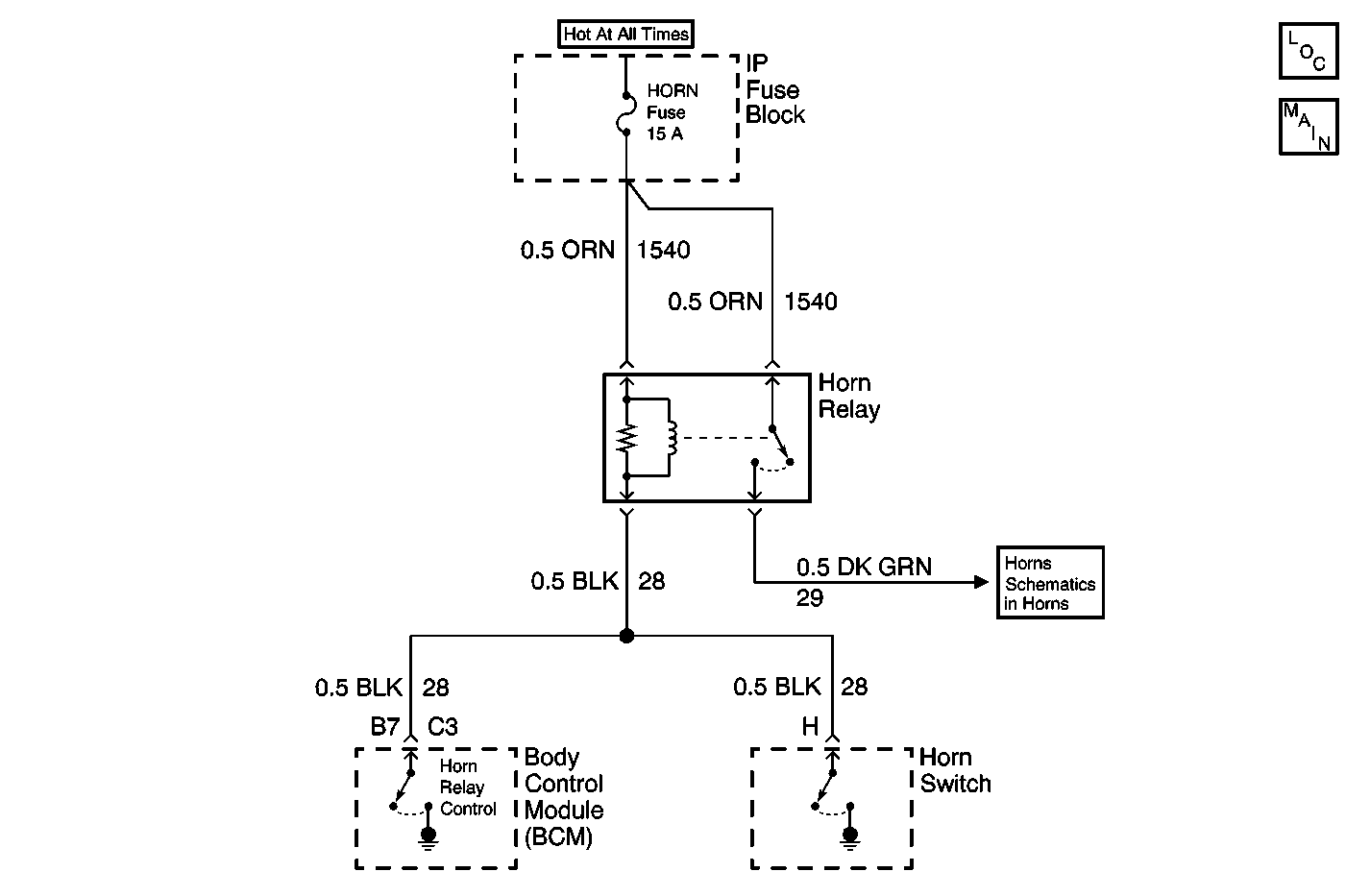
Circuit Description
The body control module (BCM) controls the horn relay. The BCM grounds the horn relay control circuit in order to activate the horn relay. The BCM also monitors the horn relay control circuit to determine if it is shorted to ground or shorted to voltage.
Conditions for Running the DTC
| • | The BCM is commanding the horn relay ON (keyfob panic button pressed) or the horn switch is pressed. |
| • | Voltage supplied to the BCM is in the normal operating range (approximately 9-16 volts). |
Conditions for Setting the DTC
The horn relay control circuit is shorted to battery positive voltage for 250 milliseconds.
Action Taken When the DTC Sets
| • | The BCM disables the horn relay control for the remainder of the current ignition cycle. |
| • | The BCM stores DTC B2753 in the memory. |
Conditions for Clearing the DTC
| • | A current DTC B2752 clears when the malfunction is no longer present and the ignition switch is cycled. |
| • | A history DTC clears after 100 consecutive ignition cycles without a malfunction present. |
Diagnostic Aids
| • | If the horn relay control circuit is shorted to battery and the horn switch is pressed, a direct short to ground will result. |
| • | If the DTC is a history DTC, the problem may be intermittent. Perform the above tests while wiggling the wiring and connectors. This will often cause the malfunction to appear. |
Test Description
The number(s) below refer to the step number(s) on the diagnostic table.
-
Listen for an audible click when the horn relay operates. Command both the ON and OFF states. Repeat the commands as necessary.
-
Tests for voltage at the coil side of the horn relay.
-
Verifies that the body control module and horn switch are providing ground to the horn relay.
-
Tests if ground is constantly being applied to the horn relay.
Step | Action | Yes | No | ||||
|---|---|---|---|---|---|---|---|
1 | Did you perform the Horns Diagnostic System Check? | Go to Step 2 | |||||
Does the horn relay turn ON and OFF with each command? | Go to Testing for Intermittent Conditions and Poor Connections in Wiring Systems | Go to Step 3 | |||||
Does the test lamp illuminate? | Go to Step 4 | Go to Step 10 | |||||
Does the test lamp turn ON and OFF with each command? | Go to Step 8 | Go to Step 5 | |||||
Does the test lamp remain illuminated with each command? | Go to Step 7 | Go to Step 6 | |||||
6 | Test the control circuit of the horn relay for a short to voltage. Refer to Circuit Testing and Wiring Repairs in Wiring Systems. Did you find and correct the condition? | Go to Step 13 | Go to Step 9 | ||||
7 | Test the control circuit of the horn relay for a short to ground. Refer to Circuit Testing and Wiring Repairs in Wiring Systems. Did you find and correct the condition? | Go to Step 13 | Go to Step 9 | ||||
8 | Inspect for poor connections at the horn relay. Refer to Testing for Intermittent Conditions and Poor Connections and Connector Repairs in Wiring Systems. Did you find and correct the condition? | Go to Step 13 | Go to Step 11 | ||||
9 | Inspect for poor connections at the harness connector of the body control module. Refer to Testing for Intermittent Conditions and Poor Connections and Connector Repairs in Wiring Systems. Did you find and correct the condition? | Go to Step 13 | Go to Step 12 | ||||
10 | Repair the coil side feed circuit of the horn relay. Refer to Wiring Repairs in Wiring Systems. Did you complete the repair? | Go to Step 13 | -- | ||||
11 | Replace the horn relay. Did you complete the replacement? | Go to Step 13 | -- | ||||
12 |
Important: Perform the setup procedure for the body control module. Refer to Body Control Module (BCM) Programming/RPO Configuration . Replace the body control module. Refer to Body Control Module Replacement in Body Control Systems. Did you complete the replacement? | Go to Step 13 | -- | ||||
13 |
Does the DTC reset? | Go to Step 2 | System OK |
